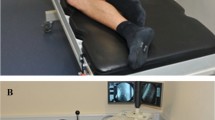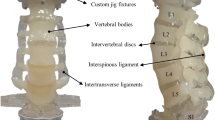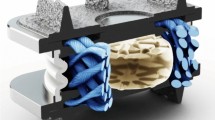Abstract
Background
The increase in the number of anterior lumbar interbody fusions being performed carries with it the potential for the long-term complication of adjacent segmental degeneration. While its exact mechanism remains uncertain, adjacent segment degeneration has become much more widespread. Using a nonlinear, three-dimensional finite element model to analyze and compare the biomechanical influence of anterior lumbar interbody fusion and lumbar disc degeneration on the superior adjacent intervertebral disc, we attempt to determine if anterior lumbar interbody fusion aggravates adjacent segment degeneration.
Methods
A normal three-dimensional non-linear finite element model of L3–5 has been developed. Three different grades of disc degeneration models (mild, moderate, severe) and one anterior lumbar interbody fusion model were developed by changing either the geometry or associated material properties of the L4–5 segment. The 800 N pre-compressive loading plus 10 Nm moments simulating flexion, extension, lateral bending and axial rotation in five steps was imposed on the L3 superior endplate of all models. The intradiscal pressure, intersegmental rotation range and Tresca stress of the annulus fibrosus in the L3–4 segment were investigated.
Results
The intradiscal pressure, intersegmental rotation range and Tresca stress of the L3–4 segment in the fusion model are higher than in the normal model and different degeneration models under all motion directions. The intradiscal pressures in the three degenerative models are higher than in the normal model in flexion, extension and lateral bending, whereas in axial rotation, the value of the mild degeneration model is lower. The intersegmental rotation ranges in the three degenerative models are higher than in the normal model in flexion and extension. The values for the mild degeneration model in lateral bending and all the degeneration models in axial rotation are lower than in the normal model. The Tresca stresses are higher in the three degenerative models than in the normal model.
Conclusion
Anterior lumbar interbody fusion has more adverse biomechanical influence than disc degeneration on the adjacent upper disc and may aggravate the adjacent upper segmental degeneration.





Similar content being viewed by others
References
Lee CK. Accelerated degeneration of the segment adjacent to a lumbar fusion. Spine (Phila Pa 1976). 1988;13:375–7.
Miyakoshi N, Abe E, Shimada Y, Okuyama K, Suzuki T, Sato K. Outcome of one-level posterior lumbar interbody fusion for spondylolisthesis and postoperative intervertebral disc degeneration adjacent to the fusion. Spine (Phila Pa 1976). 2000;25:1837–42.
Wai EK, Santos ER, Morcom RA, Fraser RD. Magnetic resonance imaging 20 years after anterior lumbar interbody fusion. Spine (Phila Pa 1976). 2006;31:1952–6.
Van Horn JR, Bohnen LM. The development of discopathy in lumbar discs adjacent to a lumbar anterior interbody spondylodesis. A retrospective matched-pair study with a postoperative follow-up of 16 years. Acta Orthop Belg. 1992;58:280–6.
Chen CS, Cheng CK, Liu CL, Lo WH. Stress analysis of the disc adjacent to interbody fusion in lumbar spine. Med Eng Phys. 2001;23:483–91.
Guigui P, Wodecki P, Bizot P, Lambert P, Chaumeil G, Deburge A. Long-term influence of associated arthrodesis on adjacent segments in the treatment of lumbar stenosis: a series of 127 cases with 9-year follow-up. Rev Chir Orthop Reparatrice Appar Mot. 2000;86:546–57.
Rao RD, David KS, Wang M. Biomechanical changes at adjacent segments following anterior lumbar interbody fusion using tapered cages. Spine (Phila Pa 1976). 2005;30:2772–6.
Weinhoffer SL, Guyer RD, Herbert M, Griffith SL. Intradiscal pressure measurements above an instrumented fusion. A cadaveric study. Spine (Phila Pa 1976). 1995;20:526–31.
Dekutoski MB, Schendel MJ, Ogilvie JW, Olsewski JM, Wallace LJ, Lewis JL. Comparison of in vivo and in vitro adjacent segment motion after lumbar fusion. Spine (Phila Pa 1976). 1994;19:1745–51.
Stokes IA, Wilder DG, Frymoyer JW, Pope MH. 1980 Volvo award in clinical sciences. Assessment of patients with low-back pain by biplanar radiographic measurement of intervertebral motion. Spine (Phila Pa 1976). 1981;6:233–40.
Chow DH, Luk KD, Evans JH, Leong JC. Effects of short anterior lumbar interbody fusion on biomechanics of neighboring unfused segments. Spine (Phila Pa 1976). 1996;21:549–55.
Chen CS, Cheng CK, Liu CL. A biomechanical comparison of posterolateral fusion and posterior fusion in the lumbar spine. J Spinal Disord Tech. 2002;15:53–63.
Handa T, Ishihara H, Ohshima H, Osada R, Tsuji H, Obata K. Effects of hydrostatic pressure on matrix synthesis and matrix metalloproteinase production in the human lumbar intervertebral disc. Spine (Phila Pa 1976). 1997;22:1085–91.
Hutton WC, Ganey TM, Elmer WA, Kozlowska E, Ugbo JL, Doh ES, Whitesides TE. Does long-term compressive loading on the intervertebral disc cause degeneration? Spine (Phila Pa 1976). 2000;25:2993–3004.
Lotz JC, Chin JR. Intervertebral disc cell death is dependent on the magnitude and duration of spinal loading. Spine (Phila Pa 1976). 2000;25:1477–83.
Kim YE, Goel VK, Weinstein JN, Lim TH. Effect of disc degeneration at one level on the adjacent level in axial mode. Spine (Phila Pa 1976). 1991;16:331–5.
Ruberte LM, Natarajan RN, Andersson GB. Influence of single-level lumbar degenerative disc disease on the behavior of the adjacent segments––a finite element model study. J Biomech. 2009;42:341–8.
Schmidt H, Kettler A, Rohlmann A, Claes L, Wilke HJ. The risk of disc prolapses with complex loading in different degrees of disc degeneration––a finite element analysis. Clin Biomech (Bristol, Avon). 2007;22:988–98.
White AA III, Panjabi MM. Clinical biomechanics of the spine. Philadelphia: J.B. Lippincott Company; 1990.
Schmidt H, Heuer F, Simon U, Kettler A, Rohlmann A, Claes L, Wilke HJ. Application of a new calibration method for a three-dimensional finite element model of a human lumbar annulus fibrosus. Clin Biomech (Bristol, Avon). 2006;21:337–44.
Rohlmann A, Zander T, Schmidt H, Wilke HJ, Bergmann G. Analysis of the influence of disc degeneration on the mechanical behaviour of a lumbar motion segment using the finite element method. J Biomech. 2006;39:2484–90.
Holzapfel GA, Schulze-Bauer CA, Feigl G, Regitnig P. Single lamellar mechanics of the human lumbar anulus fibrosus. Biomech Model Mechanobiol. 2005;3:125–40.
Skalli W, Robin S, Lavaste F, Dubousset J. A biomechanical analysis of short segment spinal fixation using a three-dimensional geometric and mechanical model. Spine (Phila Pa 1976). 1993;18:536–45.
Chosa E, Goto K, Totoribe K, Tajima N. Analysis of the effect of lumbar spine fusion on the superior adjacent intervertebral disk in the presence of disk degeneration, using the three-dimensional finite element method. J Spinal Disord Tech. 2004;17:134–9.
Adams MA, McNally DS, Dolan P. ‘Stress’ distributions inside intervertebral discs. The effects of age and degeneration. J Bone Jt Surg Br. 1996;78:965–72.
Iatridis JC, Setton LA, Weidenbaum M, Mow VC. Alterations in the mechanical behavior of the human lumbar nucleus pulposus with degeneration and aging. J Orthop Res. 1997;15:318–22.
Boden SD, Riew KD, Yamaguchi K, Branch TP, Schellinger D, Wiesel SW. Orientation of the lumbar facet joints: association with degenerative disc disease. J Bone Jt Surg Am. 1996;78:403–11.
Holzapfel GA, Stadler M. Role of facet curvature for accurate vertebral facet load analysis. Eur Spine J. 2006;15:849–56.
Serhan HA, Varnavas G, Dooris AP, Patwadhan A, Tzermiadianos M. Biomechanics of the posterior lumbar articulating elements. Neurosurg Focus. 2007;22:E1.
Adams MA, Bogduk N, Burton K. The biomechanics of back pain. Edinburgh: Patricia Dolan Churchill Livingstone; 2002.
Conflict of interest
The authors declare that they have no conflict of interest. Each of the authors has read and concurs with the contents in the final manuscript.
Author information
Authors and Affiliations
Corresponding author
About this article
Cite this article
Tang, S., Rebholz, B.J. Does anterior lumbar interbody fusion promote adjacent degeneration in degenerative disc disease? A finite element study. J Orthop Sci 16, 221–228 (2011). https://doi.org/10.1007/s00776-011-0037-3
Received:
Accepted:
Published:
Issue Date:
DOI: https://doi.org/10.1007/s00776-011-0037-3




